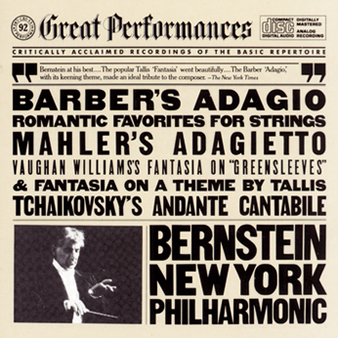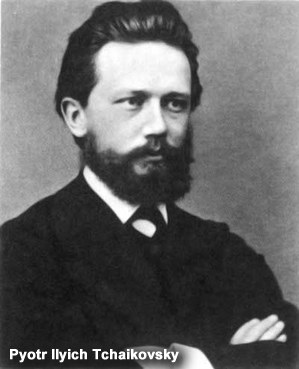 Romantic Favorites For Strings
Romantic Favorites For Strings
Samuel Barber (1910-1981) – Adagio for Strings, Op. 11
Ralph Vaughan Williams (1872-1958) – Fantasia on a Theme of Thomas Tallis
Ralph Vaughan Williams (1872-1958) – Fantasia on ‘Greensleeves’
Peter Ilyich Tchaikovsky (1840-1893) – Andante Cantabile from String Quarter No. 1, Op. 11
Gustav Mahler (1860-1911) – Adagietto from Symphony No. 5 in C-Sharp Minor
New York Philharmonic – Leonard Bernstein, conductor (CBS Records)
ONE-SENTENCE REVIEW:
Come on, it’s good – it’s just another one of those ‘Greatest Hits” packages from the vaults – not quite sure why I filed this one under ‘B’ – I suppose for Samuel Barber.
ORIGINAL LINER NOTES (uncredited):
Although four of the five works presented here were written in the twentieth century, it is not incorrect to entitle this album “Romantic Favorites.”
 (A correction is perhaps due because the full orchestra, and not just strings, performs the Fantasia on ‘Greensleeves.’)
(A correction is perhaps due because the full orchestra, and not just strings, performs the Fantasia on ‘Greensleeves.’)
The lush string lines and harmonic and melodic fluidity in many ways fall well within the flavor of the Romantic era, and certainly each work has long been popular with concert audiences.
Composed in 1936 by Samuel Barber (1910-1981), originally as a slow movement of a string quartet, the “Adagio” is built on a single lyric subject stated at the outset of the movement. Canonic treatment follows, leading to a fortissimo climax and tranquil close.
This piece was chosen by Arturo Toscanini for its first performance in 1938 and again for programs during a South American tour, the only American work to be so favored by the Maestro.
Peter Ilyitch Tchaikovsky (1840-1893) completed his First String Quartet in D Major in February 1871, and it was premiered that month in Moscow. The second movement, “Andante cantabile,” was the main reason for its great popularity and was Tchaikovsky’s first composition which incurred wide success outside of Russia.
 In 1876, a special concert was held at the Moscow Conservatory to honor Tolstoy, who was moved to tears by the movement.
In 1876, a special concert was held at the Moscow Conservatory to honor Tolstoy, who was moved to tears by the movement.
The “Andante cantabile” is in three-part form and is based on the Russian folk tune “Vanya Sat on the Divan” that Tchaikovsky obtained from a carpenter in Kamenka, Russia.
Gustav Mahler (1860-1911) completed his five-movement Fifth Symphony in 1902. The brief fourth movement “Adagietto” (only 103 bars long), marked Sehr langsam (very slowly), is scored for strings and harp. It is in great contrast to the more turbulent music heard before it in the Symphony.
After its premiere in Cologne in October 1904, Mahler wrote to his wife, Alma, “Performance excellent! Audience immensely interested and attentive – despite all their puzzlement in the early movements! After the Scherzo even a few hisses! Adagietto and Rondo seem to have won the day.” The “Adagietto” is perhaps the most immediately accessible of all movements from Mahler’s symphonies.
 Ralph Vaughan Williams (1872-1958) wrong Fantasia on “Greensleeves” in 1929 for his opera Sir John with Love, based on Shakespeare’s The Merry Wives of Windsor.
Ralph Vaughan Williams (1872-1958) wrong Fantasia on “Greensleeves” in 1929 for his opera Sir John with Love, based on Shakespeare’s The Merry Wives of Windsor.
“Greensleeves” was a hit song of the late 1570s, and Shakespeare mentioned it more than once in his plays. It was even rumored to have been written by Henry VIII, a composer of many similar tunes. The Fantasia also incorporates as a middle section another English folk tune, “Lovely Joan.”
Vaughan Williams: Fantasia on a Theme by Thomas Tallis: Thomas Tallis (1505-1585) was one of the most distinguished of early English musicians, a predecessor both of William Byrd and John Wilbye.
Tallis wrote a set of eight tunes (found in the Metrical Psalter of Matthew Parker, Archbishop of Canterbury), one on each of the ecclesiastical modes. These date from 1567. The theme utilized by Vaughan Williams is the third in the sequence, in the Phrygian mode.
 According to Vaughan Williams’s wife, Ursula: “He took this tune as a theme for a fantasia, using the strings of the orchestra grouped as a solo quartet, a small string band, and a larger body of players: with the Norman grandeurs of Gloucester Cathedral in mind and the strange quality of the resonance of stone, the echo idea of three different groups of instruments was well judged… The audience in the Cathedral that September evening had come to hear Elgar conduct Gerontius, but before that work Ralph stood in front of them, looking taller than ever on the high platform, dark haired, serious, inwardly extremely nervous, and the grave splendour of the Fantasia on a Theme by Thomas Tallis was heard for the first time.”
According to Vaughan Williams’s wife, Ursula: “He took this tune as a theme for a fantasia, using the strings of the orchestra grouped as a solo quartet, a small string band, and a larger body of players: with the Norman grandeurs of Gloucester Cathedral in mind and the strange quality of the resonance of stone, the echo idea of three different groups of instruments was well judged… The audience in the Cathedral that September evening had come to hear Elgar conduct Gerontius, but before that work Ralph stood in front of them, looking taller than ever on the high platform, dark haired, serious, inwardly extremely nervous, and the grave splendour of the Fantasia on a Theme by Thomas Tallis was heard for the first time.”
TRACK LISTING:
- 1: Samuel Barber: Adagio for Strings, Op. 11 [9:56]
- 2: Ralph Vaughan Williams: Fantasia on a Theme of Thomas Tallis [18:12]
- 3: Ralph Vaughan Williams: Fantasia on “Greensleeves” [4:56]
- 4: Peter Ilyich Tchaikovsky: “Andante Cantabile” from String Quartet No. 1, Op. 11 [9:24]
- 5: Gustav Mahler: “Adagietto” from Symphony No. 5 in C-Sharp Minor [11:05]
FINAL THOUGHT:
This is indeed one of those lights-down-glass-of-wine (or four) discs that we all love to play once or twice a year.
 Emily Sachs – President – Manka Music Group (A division of Manka Bros. Studios – The World’s Largest Media Company)
Emily Sachs – President – Manka Music Group (A division of Manka Bros. Studios – The World’s Largest Media Company)


